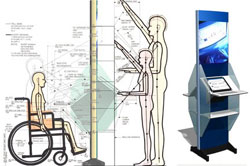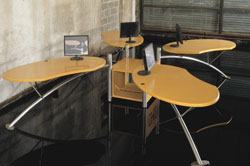Article
Design a key element of any kiosk project
Design is one of the most critical aspects of a successful kiosk project, even if deployers don't realize it at first.
July 27, 2003
Remember the Darth Vader effect? It occurred in the early days of ATMs, when the units had a dark, mysterious and imposing look. Consumers were nervous about putting their personal information into such intimidating devices, and thus passed them by on their way to a smiling teller.
That was a design issue that had a major impact on consumer acceptance of ATMs. Design is no less of an issue today in financial services and other areas of self-service.
Ron Bowers, senior vice president of business development at Grafton, Wis.-based Frank Mayer & Associates Inc., said design is one of the most critical aspects of a successful kiosk program.
"Many projects are driven by technology like new software applications. Customers take the design of the enclosures secondary," said Bowers. "That misses the point. Retail, in particular, is driven by brand image and interaction with consumers. That's visual merchandising 101."
 |
Sonic's kiosk design considerations |
Educating Customers
Often a customer has costs and the overall goal of the kiosk project in mind when approaching self-service vendors. The customer may not give much thought to the look or usability of the unit. It's up to the vendor to listen to the client and visualize what they are trying to achieve.
"Businesses are driven by the consumer experience, which could be positive, negative or neutral. A neutral experience can be as bad as a negative one," said Bowers. "Consumers are bombarded with calls to action daily. You have to stand out."
Klaus Rosburg, president of New York City-based design consultancy Sonic Design Solutions Inc., said what makes his job most interesting is designing kiosks that are usable for everyone. "They must not only have universal appeal, but also an intuitive interface. Public kiosks are used by young people, handicapped people, older people, people of all ethnic groups. Human factor and interface studies are important parts of our design process."
The challenge in public design is to make the products durable so they can withstand vandalism and regular high user traffic. The designers at Sonic take two different approaches: using high-impact materials, which are easy to maintain; or using lower-cost removable panels that can be replaced. The design and manufacturing teams explore new materials and processes to improve designs and reduced maintenance costs, Rosburg said.
Like Sonic, Frank Mayer does not have kiosk designs sitting on a shelf. They don't take stock units and tailor them for a client. They take the client's specific needs, environment and typical user to heart and design an experience.
 |
Sonic kiosk design |
Early and often
Bowers said it is important to include a design team in early client discussions, and to thoroughly research the customer environment before embarking on a project. Frank Mayer's design team includes graphical and industrial engineers and model makers. "Design is an art form," he said. "It creates not only a look but a feeling."
The design team works closely with the technology team, which determines what hardware, software and peripherals the project needs. Will it be a big box with lots of CPUs, a small-footprint unit with a thin client or embedded system? Will the kiosk need a touchscreen, flat panel with keyboard or a track ball? These hardware factors influence design.
Other design considerations include:
- Where will the unit be placed?
- Will it be freestanding in an easy-access space, or is space at a premium and the unit have to be wall-mounted or attached to a pole?
- Will the unit be in a cluttered area, like close to the checkout aisles?
- Will it be in line with existing fixtures and have to be integrated with that look?
- Size of the project. Rosburg said, "If clients want only a few kiosks, the design is restricted by construction technology. We want to make the units inexpensive, but still good-looking."
- Longevity of the project. The kiosk must be a tool that can be used, serviced and updated through the years.
Different users, different looks
Rosburg said that sometimes a kiosk can be fun and engaging, almost like a gaming unit to encourage users to try it. But for a bank, a kiosk must be serious-looking and sophisticated to establish a sense of trust and confidence. It's all about brand.
Bowers said sometimes a customer will want the kiosk to become an icon for its brand. In the case of John Deere, for example, the company wanted Frank Mayer to design a kiosk that customers would immediately associate with the brand, no matter what the size or design of the retail showroom.
"If you squint your eyes and look at the John Deere kiosk, it looks like the front end of a tractor," he said. "The kiosk has a low profile, is open and has a small footprint, but it is very strong in brand identity." See related story, "John Deere poised to widen kiosk deployment."
Rosburg said bigger corporations often have guidelines and specifications defining the corporate identity and regulating the use of colors, textures and materials.
"We have to look at the project and establish a design brief. Every client has its own brand identity, which we do implement into our design to elevate the visibility of the brand or of the company itself," he said.
"urn:schemas-microsoft-com:office:office" />
"A kiosk for Coca-Cola, for instance, which serves all ages and ranks of society, can communicate fun and usefulness. There is no question the color palette would be red with white and the design would incorporate its classic wave. It is important that a design reflects the company's philosophy and that it is appropriate for the intended target audience," said Rosburg.
He said a kiosk has to be attractive to make a user step up, and just like with any other product the design has to be intuitive and self-explanatory. If it is at all complicated, people won't approach and use it.






